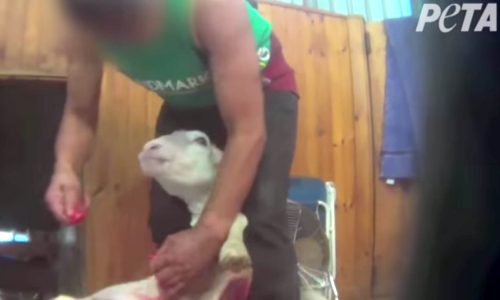
PETA’s Undercover Shearing Videos Expose Horrific Sheep Abuse in U.S. and Australia

It would be tough to think of any disgusting, gutless acts that aren’t featured in new videos about brutal sheep shearing in Australia and the U.S., produced by People for the Ethical Treatment of Animals (PETA).
The videos are full of undercover footage, not unlike the last month’s video of buried-alive chickens produced by Washington DC-based Compassion Over Killing. However, these might be worse.
With sheep getting punched in the face, dragged on the floor, beaten with hammers and even swiped across a wooden floor to wipe urine, both videos are certainly more graphic. Be warned.
PETA investigators documented 70 workers employed by nine shearing contractors in Victoria and New South Wales—Australia’s top wool-producing states—as well as South Australia. Collectively, they shear about 4 million sheep per year.
Even worse, many of the shearers began their kicking and punching after the sheep expressed fear. They were also often deprived of food and water before the process even began.
One explanation for the cruelty is that most shearers are paid by volume instead of by the hour. That systematically encourages fast-paced, violent work.
It’s not just an Australian practice, though. PETA also exposed shearers in the U.S. for being just as violent in another video. One shearer calmly says, “I might have killed it,” after he is shown twisting its neck.
In the U.S., PETA’s investigator documented 14 ranches in Wyoming—the country’s second-leading wool producer—as well as Colorado and Nebraska. In 2013, 3.7 million sheep were shorn in the U.S.
PETA is asking consumers to refrain from buying and wearing wool products as a result of its findings. It also hopes people will sign its petition asking J. Crew and Ralph Lauren to drop sheep products from their clothing lines. Click here and scroll to the bottom to find the petition.

 233k
233k  41k
41k  Subscribe
Subscribe 